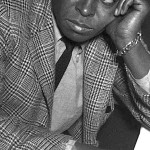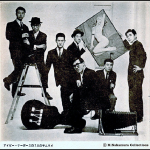Contributing writer James Kraus is an arch-connoisseur of the 1950s and ’60s. Herein he takes us on a tour of the years of the Ivy heday, giving us a broad overview of what else was going on in American life besides penny loafers and buttondown collars. Part one covers the first half of the heyday, which was characterized by affluence and confidence in the future.
* * *
The Ivy Heyday of 1954-1967 is regularly dissected in sartorial terms here, but what else was going on? What made this era so special? We will now be taking a look, starting below with the years 1954-1959.
It was a time most notable of optimism and prosperity. In 1954, post-war food rationing finally ended in Britain, France was enjoying the height of The 30 Glorious Years and Germany was celebrating its Economic Miracle. In the U.S., Wall Street, Madison Avenue, Abstract Expressionism, Modernist architecture and Cool Jazz catapulted New York to the global epicenter of the intersecting worlds of art and commerce.

The late-fifties first and foremost were about enjoying life after two decades of depression and war, followed by a few years of material shortages and wage and price controls instituted during the Korean War. In February of 1953; the latter were lifted, and in 1954 the stock market finally eclipsed the mark set in September of 1929. American was set to enter a period of seemingly unlimited prosperity and abundance.
In October of 1956 Fortune magazine published a glowing account of the booming consumer-driven economy stating, “Never has a whole people spent so much money on so many expensive things in such an easy way as Americans are doing today.” A few months later the magazine noted that the number of American families moving into the middle class was increasing by over one million a year and projected that by the decade’s end, half the families in America would be included.

Millions of WW II veterans; graduating with G.I. Bill-financed college degrees, fueled the expansion, buying homes in burgeoning new suburban developments with low-interest zero-down payment G.I. loans.

The mass migration to the suburbs saw housing tracts spring up across the country. Many of these new subdivisions featured exclusively up-to-the minute Modernist homes, not just in newer areas like Palm Springs, CA and Las Vegas, NV but in more established locales as well, epitomized by such developments as Cumberland Estates in Knoxville Tennessee.
Other suburbs were built using modern floor plans like the Ranch and the Split-Level, but trimmed with traditional detailing including paneled doors and faux window shutters.

Regardless of architectural style, many new dwellings were furnished with at least a modicum of modernist furniture pieces in what was the Golden Age of American furniture design. Prior to WWII, mass-produced American furniture was based on interpretations of period European designs. An increasing global interest in contemporary furnishings paved the way for American designers to push the envelope. These mid-century creations by Charles Eames, Harry Bertoia, Eero Saarinen, George Nelson and others were not only the first genuine world-class American furniture, they were more often than not, best in class.

Many examples were constructed of new materials developed during the war including molded plywood and rigid polyester fiberglass resin. As testament to their integrity, most of the pieces by the aforementioned designers remain in production to this day.

In addition to new styles of furniture, homes of the era were filled with the latest gizmos: televisions, washers and dryers, dishwashers, air conditioners, freezers, floor waxers, pressure cookers, blenders, barbeque grills, transistor radios, hula-hoops and the occasional aluminium Christmas tree.

Many new technologies were developed during the war years that did not reach large-scale commercial use until the 1950s: jet propulsion, rocketry, high-octane fuel, electronics, nuclear power, frozen food and freeze-dried coffee.
As the public unquestionably embraced new technology with open arms, new became synonymous with better. The highest accolade that could be bestowed upon any new product was new and improved. Powdered orange juice (Tang, 1959); why not? Even belching smokestacks were a sign of progress and economic vitality. To question scientific progress was to mark oneself an insufferable Luddite.

In a prized corner of the new living or family room would be a single-channel monaural Hi-Fi unit on which to listen to the latest Cool Jazz or Bossa Nova. Meanwhile teenagers could play the new-fangled Rock & Roll in their bedrooms on the Regency TR-1 pocket-size transistor radio which reached the market just in time for the Christmas shopping season of 1954.

In rather stark contrast to today, the fifties consumer embraced a generous color palette. With the exception of the occasional contrasting roof, two-tone cars had been dwindling in popularity since the late 1930s as separate fenders became integrated into overall body design.

That trend began to reverse in 1950 when Ford introduced the Crestliner with a two-tone lower body. By decade’s end, two and even three-tone cars would be commonplace in a rainbow of colors including highly saturated turquoise and coral, and the occasional pink.

Color wasn’t limited to the driveway; in 1953 Frigidaire introduced the first popular-priced appliances available in color finishes. As an alternative to traditional white, buyers could now opt for Stratford Yellow or Sherwood Green. Other manufacturers responded with their own special palettes, and in short order all major kitchen appliances were being offered in a rainbow of color from pastel pink to charcoal grey.

America became an increasingly mobile society. Construction of the Interstate Highway System began in 1956. A few years later, the introduction of the Boeing 707 and Douglas DC-8 ushered in the Jet Age.

Abstract Expressionism with its emphasis on color, texture and self-expression with out regard for depth or perspective was the first American art movement to achieve world acclaim and was of sufficient power to shift the center of the art world from Paris to New York. It was eventually dubbed American-Type Painting by art critic Clement Greenberg in 1955.
While some perceived and bemoaned the veneer of conformity in cookie-cutter suburbs and The Man in the Grey Flannel Suit, there were undercurrents of change bubbling beneath the surface in the form of the Beats in Greenwich Village and San Francisco; and Marlon Brando and James Dean on the silver screen.
Black culture first began entering daily American life via popular sports figures like 1954 baseball All-Stars Jackie Robinson and Willie Mays, and musicians Chuck Berry and Nat King Cole.
For the first time in American life, youth became a separately defined market, and the first to tap into it in a big way was Elvis Presley who sold up to $75,000 worth of records a day in 1956.

Sexual mores began loosening. Playboy, first published in March of 1953, was selling over one million copies a month by the end of the decade. Peyton Place, with its tales of lusty women, sold 60,000 copies in less than two weeks upon its release in 1956. Three years later, the racy Lady Chatterley’s Lover was ruled to be no longer obscene, paving the way a few years later for similar rulings regarding Naked Lunch and The Tropic of Cancer.
Rising standards of living fuelled a restaurant boom, and Continental Cuisine was all the rage: Coquilles Saint Jacques, Hungarian Goulash, Beef Stroganoff, Smörgåsbords, Weiner Schnitzel and countless other international delights. Diners also increasingly sought more than food; they wanted excitement. Tableside preparation and presentations à la flambé were especially popular at trend setting mid-century stalwarts like Forum of the Twelve Ceasers in New York and Chicago’s Pump Room.

In 1957, Sputnik heralded the dawn of the Space Age. Every hour and a half, American amateur radio operators could hear the relentless beep-beep-beep of the Soviet satellite as it orbited overhead at 18,000 mph.
The public, already enthralled with outer space and flying saucers, became even more enchanted. Galactic, planetary and satellite-themed imagery and appliqués began adorned modernist apartment blocks and commercial signage, automobiles and appliances; The space-themed Stardust Resort and Casino opened in 1958, just a few months before the unveiling of the Ford Galaxie.

The launch of Sputnik produced another side effect: the San Francisco Chronicle’s Herb Caen described the denizens of North Beach as being as “far-out” as Sputnik, and thus christened them Beatniks. By decade’s end Beatnik characters would populate numerous Hollywood movies and enter American living rooms at 8:30 Tuesday evenings in the form of Maynard G. Krebs in The Many Loves of Dobie Gillis. — JAMES KRAUS
 James Kraus is the founder of Jet Age Media.
James Kraus is the founder of Jet Age Media.











Oh for optimism and prosperity!
Thanks for pitching this to me, James.
Good piece. Great pictures.
I have a question. If the 50s and early 60s were (and is so) a golden age,why Hollywood hate they?
http://houstonstrategies.blogspot.it/2009/01/why-does-hollywood-hate-suburbs.html
An accurate representation of my childhood. The 60’s assasinations and Vietnam war and Watergate seriously wounded our optimism. I hope not fatally.
We used to look forward to the future.
Maybe I continue to clothe myself in the style of that era because it reminds me of my hopes for a bright future.
Hope never goes out of style either.
Great piece, Mr. Kraus. I know that the heyday was not all tailfins and Audrey Hepburn in Capri pants, but there was a feeling of optimism, particularly economically, and it is nice to be reminded through these beautiful images. It was my parents’ era more than mine, but I still feel very much at home in that world in everything from music and movies to clothing and design. Among my recent time-machine experiences was a dinner at the new/old Grill in the Seagram Building (formerly the landmarked Four Seasons Grill Room from 1959). Yes, it cost too much and I may not head back anytime soon, but it was quite an evening of great old-fashioned service, food and wine in a beautiful room.
Carmelo:
Over the last decade or so, nearly everything in America has unfortunately become polarized. Like most things in life, suburbs could be good or bad. They started out as homes for the middle classes as the article you linked to states; but later upscale versions were developed, often centered around a country club.
A handful even had a small shopping center attached. One of the best examples was Park Forest Illinois; it featured its own shopping, churches and parkland specifically designed and situated so as to encourage social interaction. The development and lifestyles of Park Forest were well documented in The Organization Man by William H. Whyte (1956).
Back in the day, Hollywood actually celebrated suburban living. It was the featured setting for many popular TV shows like Bewitched and I dream of Jeannie, as well as numerous movies like The Man in the Grey Flannel Suit, Bachelor in Paradise, Divorce American Style and The Graduate..
I think it’s impossible to overestimate the impact of the GI Bill. The men who would’ve been just the best mechanics and technicians in their little towns and city neighborhoods became engineers, chemists, physicists and launched waves of innovations. And, antecedent to that, military service had mixed the regions and classes and sent them off to new places. There was no longer as much tendency to stay where you grew up and take those same old jobs.
Charlottesville,
Though I was alive, the late 1950s were definitely my parent’s era as well. Like most people my age, my original conception of the period consisted of poodle skirts, Doo-Wop music, The Fonz and pink cars with absurdly baroque tailfins.
Due to a lack of interest in any the aforementioned, I harbored little affection for the era until I learned more about it through extensive reading and screening of period films. I eventually came to see the late 1950s as a vital precursor to the early 1960s; my favorite period of the late, lamented 20th Century. Now, much of my furniture and a good portion of my movie and music collections hail from the latter fifties.
I wish I could have joined you on your dining adventure!
I listened to some doo-wop this weekend while cycling around. It had been a long time. Still enjoy it — it’s so of the period. The rare, unknown stuff is often better than the big hits that are remembered.
To anyone interested in this era’s culture of optimism and prosperity, I recommend the book Populuxe, by Thomas Hine.
CC,
Care to offer a few doo-wop suggestions? Especially the “unknown stuff.”
Is this considered doo-wop? It’s circa ’67, so…maybe not?
https://www.youtube.com/watch?v=CdoXBZnBHK4
Populuxe is an entertaining look at the era, but unfortunately focuses excessively on kitsch aspects of the period, or what I call the usual suspects: Grotesquely befinned three-tone automobiles, starburst atomic chandeliers, pink flamingoes… The GTL artifacts if you will.
I hope that someday Matt Weiner (creator of Mad Men) or someone else with his amazing eye for detail will produce a TV show that would show the world the suave and quite elegant upscale 1950s which has been all but forgotten: Men in crisp Ivy suits driving Jaguar Mark I Sedans, Mercedes-Benz 300 SL Roadsters, Citroën DSs, Lincoln Continental Mark IIs and Raymond Lowey-designed 1953 Studebaker Starliner Commander Coupés, lounging in Eero Saarinen Womb chairs, strolling past Jackson Pollacks hanging on walls of genuine teak, and listening to Monk or Coltrane while marinating ice cubes in their favorite libation.
Great article about a great era. When I think of the 1950’s, I think of cookie-cutter conformity but not in a bad way. Interesting to read about the atomic/modernist zeitgeist that also defined those times.
I too enjoy some doo-wop in addition to GASB/jazz standards. It’s all America’s classic music.
Mark Russell, very well put. I’m 67 and spent that era as a happy child. Discovered Trad clothing in the mid 60’s and have been wearing it ever since. Never thought about it until now but I think my khakis, OCBD’s, madras, seersucker, penny loafers, tassels,etc. may be a yearning to return to the times.
Great piece.
SE, try these:
https://www.youtube.com/watch?v=93PVCWy96lE
https://www.youtube.com/watch?v=MuAM7q7d8ss
https://www.youtube.com/watch?v=e-e6TbUxhqs&spfreload=10
https://www.youtube.com/watch?v=VoDCBMOwrZI
https://www.youtube.com/watch?v=sSlsTaq96O4
The seeds were sewn pre-rock and roll:
https://www.youtube.com/watch?v=WYtHNep4qHA
https://www.youtube.com/watch?v=gPdidRreduM
John Carlos, always a joy to connect with a kindred spirit. Keep on, keeping on!
Excellent peice, Mr. Kraus. I, too, have a long and abiding affection for the Golden Age of America, so I really enjoyed this piece. I’m looking forward to Part II.
Carmelo, liberals of all stripes, Hollywood or otherwise, hate the 1950s because it was the peak of not just American culture but also of Western civilization. Decency and high standards abounded, while aberrant behavior and attitudes were marginalized, and rightly so. For the modern liberal, the moral order is inverted: what past generations held to be good, liberals hold as bad, and vice-versa. Therefore, they despise the 1950s for its goodness, which they see as badness.
This is not to say that it was ideal: it was still populated by fallible humans, fraught with human foibles. That’s all that liberals see, however, so they bray endlessly about the “oppression” and “racism” and “sexism,” etc., of the age. No era is perfect, but our ancestors built, and lived in, a stable, peaceful, orderly society, where families were strong and intact, standards were high and adhered to, and dysfunction was not only stigmatized, but also far less prevalent than in our own age.
I’m certain that some readers will immediately point out this defect or another of the age. I’ve already acknowledged that it was imperfect; I’m just saying that in most ways, it was less imperfect than our own highly disordered age.
For those linguistic conservatives among us, when Henry Contestwinner says “liberal”, he means “leftists”.
Tv was becoming less novelty and gadget. It was becoming a democratizing force. By 1959 half of American households had a black and white television. In 1951 the number was 12,000. No invention or appliance made a faster entry into the American household than television. Television made America simultaneously larger and smaller. It enhanced our understanding of society through varied expositions. It made us smaller by connecting us via shared experiences of witnessing the world events. As we left cities for suburbs, tv connected us to events and entertainment. It became a unifying device. In the late 50s Tv aired the McCarthy trials. his definition of anti American activities was on display and the emerging industry of TV news helped expose him as a charlatan, via Edward r. Murrow on cbs. Tv brought the Little Rock nine into the homes of millions of Americans who saw for themselves black teenagers being abused as they tried to gain entry to a public high school so to educate themselves. Several historians believe the “60s” anti establishment movement was fueled with the proliferation of tv because white Baby Boomers, as young people, had difficulty reconciling the security and prosperity of their middle class lives with images beamed into their living rooms of fire hoses turned on blacks, and McCarthy asking “European Americans” for loyalty oaths. Tv redefined politics and helped JFK win the White House in 1959. We take it for granted today. But 60 years ago tv was about to permanently change society. Shifting to music, 1959 was one of the greatest years for jazz recordings with Miles Davis and John Coltrane breaking out new sonic languages and melody and rhythm. And ’59 was the publication of Jack Keuorac’s “on the road” another type of music , but in novel form. Oh yes, the “60s” were already brewing.
Contrary to today’s revisionist history, only a small minority of American’s in the 1950’s were listening to Cool Jazz or Rock ‘N Roll. Mostly ignored today is the fact that Pat Boone was the most popular singer in America at the time. Also, Doris Day, Tennessee Ernie Ford and Eddie Fisher were known to practically everyone. Percy Faith was far more mainstream than Mile Davis. The average college student in 1957 could not have told you who Chuck Berry much less John Coltrane even were. Of course, tastes dramatically changed in the late 1960’s along with the sartorial taste revolution much chronicled here. Most of the artists that we are taught today were classic 1950’s musicians were not actually that popular at the time.
Jerry,
It was a pleasure to read a realistic remembrance of what we were actually listening to in the 1950’s.
In 1958, we were listening to the Kingston Trio singing “Tom Dooley”.The single sold more than 6 million copies.
https://youtu.be/AoBLGE2cCdU
Here’s a couple of other observation that come to mind when I recall the 1950’s:
The first suburban house I purchased in New Jersey in 1958 was so shabbily built with “new” material and techniques that the walls were virtually paper stock. Fortunately, the neighborhood no longer exists. That was my first and last foray into “modern” architecture.
The closets in everyone’s homes were what today would be considered broom closets. I owned only 2 suits as did most professional men I knew. I worked at a large law firm in NYC from ’58 to ’67. The only status clothing item back then was well shined shoes. God forbid your shoes didn’t have a mirror finish.
Most Americans (both white and black) shunned or ignored the civil rights movement in the 1950’s. As noble a cause as it ultimately proved to be, it wasn’t until decades later that most people reluctantly began to see it that way. People my age today feel apocryphally compelled to day they were involved in the civil rights movement back in the hey day when in fact they saw it as an aberration at the time.
A salad at a 5-star restaurant consisted of half a canned pear and a cherry on top of a lettuce leaf. We ate beef and potatoes nearly every day. All Italian restaurants served only spaghetti, that’s all. Chinese restaurants were everywhere, like today, however they all served the same thing: Chop Suey. I never saw a pizza until the early 1970’s.
Since this covered 1954-59, allow me to share what adults were listening to in 1954.
https://youtu.be/nLabIlGXcys
I saw this as soon as CC put it up, and I knew it would only be a half-dozen posts before we veered away from clothes, music & architecture (thank you, btw, to James Kraus for the images and narrative) to social/political commentary.
God knows I’ve chronicled on these pages my own nostalgia for a different era (the Reagan 80s) but I like to think I’m objective enough to say the same about that time period as I would in response to Henry Contestwinner’s assertion that ‘liberals hate the 50s because it was the peak of American culture and Western civilization’: it all depends on who you ask. I submit that a negro (to use the parlance of the day) laborer or sharecropper in the Jim Crow South might have a different view than does our little group on whether the late-50s were the pinnacle of American culture, or of the ‘decency and standards’ that were enforced upon him. That’s not ‘white guilt’ or some other silly epithet, it’s just historical reality: how you view things, for better or worse, depends on where you’re standing at the time.
Put differently, I continue to hope that we can say we liked the khakis but hated the tail-fins without also feeling compelled to opine on who “hates America.”
Killed, Charlottesville, GS, Tulip and Paul – Kindly comments much appreciated!
Has anyone notice the following?
In the lead photo of the Colonial White over Inca Gold 1957 Ford Fairlane Town Victoria, the gentleman is wearing an OCBD as well as a Cartier Tank-style wristwatch while grasping a pair of tortoiseshell sunglasses.
Further down is a picture of a man in a straw hat and pocket square walking by an Azure Blue and Colonial White 1958 Ford Fairlane 500 Club Victoria. That’s Bob Hope in a scene from 1961’s Bachelor in Paradise.
Of course Percy Faith was more popular than Miles; that’s what made Miles cool.
What you were listening to in the ’50s depends largely on whether you were square or hip and whether you score high or low for Openness in the Big Five personality test, a standard in psychology.
I took a test online recently and scored in the 96th percentile, which surprised me I guess not for how open I am, but how closed apparently everyone else is. Openness covers intellectual curiosity, aesthetic appreciation, interest in variety, and in touch with feelings. It’s also associated with creativity and a liberal political stance. Low openness generally results in conservatism.
My father would score a 4 in Openness, and he and my mother’s music collection from the early ’60s consisted of bubble-gummy pop/rock and roll tunes from his early years that he transferred from 45 RPM to reel-to-reel, plus folk singers and the Beatles and Stones.
My parents couldn’t dig jazz at all.
There was also a large amount of classical by big name artists, such as Leonard Bernstein, Glenn Gould, and Van Cliburn.
That last part tells you a lot about the changes since then. This was an era when TV shows and mainstream magazines like Time would cover serious music, and people had some general interest in it, or at least felt they needed to feign such an interest.
The music collection ends abrumptly right around the time I was born.
Alleging that young people were listening to R&R is not “revisionist history” as Jerry alleges. If we look at the Billboard Top 20 of 1957, Elvis Presley alone occupied four slots, including Number One (compared to Pat Boone’s two hits) while other R&R acts on the list included the Diamonds, Buddy Konx, Tab Hunter, Sam Cooke and the Everly Brothers. Just over half the Top 20 hits were by R&R acts.
That might qualify as a “small minority” under the New Math but that didn’t appear in classrooms until the 1960s.
Christian,
Thanks for bringing up the matter of feigning a interest in x.
It seems that today we have to feign an interest in jazz, bit loafers, and red trousers in order to be considered dyed-in-the-wool Ivy aficionados.
James Krause,
Thanks for pointing out the gentleman’s OCBD, Cartier tank-style watch and tortoise shell eyeglasses.
Might I also point out his haircut?
@ BB
No need to feign a personal interest, just accept that they’re part of the story. That’s not so hard.
A man should never feel a need to feign interest in a subject or object unless it might happen to be something his wife or boss likes…
P3 Tortoise:
Indeed! And let’s not overlook the gal, she’s quite glamorous with a nice multi-string pearl necklace and a stylish pair of black satin gloves.
Jerry:
I am rather intrigued by your limited access to culinary treasures during the period in question, being that you were in New York City. I just glanced at a 1958 menu from the Plaza Hotel’s Oak Room. The salad section offers a choice of Salade du Chef, Mixed Greens, Romaine, Bibb Lettuce, Belgian Endive, Lettuce and Tomato, Avocado with Grapefruit* and last but not least, Escarole à la Italienne. A cornicopia that would be hard to top today.
Besides beef, I see a mouth-watering choice of alternative entrées including Rock Cornish Game Hen, Jumbo Squab Casserole, Long Island Duck, Roast Turkey, Grain-Fed Chicken, Loin Lamb Chops and Veal Scaloppini.
* Apparently avocado is a really big thing at the moment, but it was already popular with foodies in the late fifties, often seen on menus as “Alligator Pears.” James Bond orders one in the 1953 novel Casino Royale.
Googie (“space age”) architecture, Eichler homes, George Nelson accessories and furniture, Beach Boys…nuclear war practice drills in school…I used to miss it all. Now not so much, though, as everything has been reduced to ashes and rubble. My Chocolate Lab is still in a good mood, though, so there’s that.
We watched those old “Duck and Cover” videos in school. Crazy to think of how serious the threat of nuclear anhiliation must have been.
@ Henry
I can guess what you are talking about, but I’d be interested to see you clarify exactly what marginalised behaviours you consider aberrant.
@ Paul
I agree. One day I might be really nostalgic about the early 2000s (not the fashion, just the being young). I didn’t even exist in the fifties so I can’t make a comparison from personal experience, but as a mixed-race queer it’s likely I would’ve had a hard time. Don’t get me wrong, I’m still interested in the Ivy League Look and fifties/early sixties style in general, but I’m not going to kid myself about how I’d fit in during those decades either.
@Mr. Krause
The Jaguar Mark 1 was a great car. Had one in Racing Green in the early 90s. In board rear brakes would have broken the bank so had to sell. My favorite car with burl dash push button start cloth sun roof and rear wheel skirts. P wagon of the first order.
Will
Paul,
Carmelo asked a question, and I gave him an answer.
Having said that, no one, least of all me, will defend Jim Crow. Let’s think rather about the situation of blacks in general (or negroes, if you prefer), particularly outside the South.
Leaving aside the technological changes that affected us all, blacks were generally better off in the 1950s than they are now, in part due to pressures to conform to societal standards, such as holding a job, getting married, and going to church. While blacks were often segregated physically if not legally, there were thriving black communities with black-owned businesses catering to black clientele, and the black middle class was growing as a result. Even those who were not moving into the middle class at least had jobs and were productive members of society.
In the 1950s, blacks would at least start life by being born; in our day, in New York City, every year more black babies are aborted than are born. Once born, a 1950’s black baby would most likely be raised by both parents. Today, the out-of-wedlock birthrate for blacks is so high—around 72%—that weddings and marriages are alien to most blacks. Above that, absentee fathers are a significant factor in a host of social dysfunctions, including criminality, substance abuse, and educational non-achievement.
Having made it out of the womb intact, a black youth of the 1950s was unlikely to succumb to gang violence or a drug overdose. Vocational training was still available, so those whose talents lay in areas other than academics could at least get the education they needed to hold a job—something else that has become increasingly rare among young blacks today.
No, most blacks did not enjoy the same standard of living as whites in the 1950s, but at least they were born alive, unlikely to be killed while young, had less likelihood than now of falling into antisocial behavior, and had good prospects for living decent, productive lives.
What happened? Much of the blame lies with LBJ’s failed “War on Poverty,” which has been, depending on what you think the goal was, either a enormous failure or a fantastic success.
If you think the “War on Poverty” was supposed to get people out of poverty, then it has been a multitrillion-dollar failure. However, once we know that with the left, things are never about what they left claims they are about, we can look for the actual goals and judge accordingly. The “War on Poverty” is not, and has never been, about bettering the lives of the poor. It has always been about increasing the size and power of government, and about accomplishing those goals by creating people dependent on government. By subsidizing certain behaviors, including out-of-wedlock birth, the “War on Poverty” and its ancillary programs have promoted those behaviors. By these standards, the “War on Poverty” has been a huge success.
(Aside to Falcon: liberals are those whose leftism is attenuated; they both lie in the same part of the spectrum, with leftists simply being more consistent in their leftism than liberals.)
Here are two greats articles by Thomas Sowell which bolster the points made by Henry.
https://www.google.ca/amp/amp.nationalreview.com/article/420807/scapegoat-strife-black-community-thomas-sowell
https://www.google.ca/amp/amp.nationalreview.com/article/425155/legacy-slavery-excuse-social-degeneration-thomas-sowell
Thanks for the support and supporting articles, GS. I particularly like the second one.
Thank you, Henry, for your continued comments on this site. Happy to help.
Proposed soundtrack for this post: Donald Fagen, “I.G.Y.”
Speaking of the 1950’s color palette, coming home from elementary school one day I found my dad repainted our house in the then-popular colors of black, pink and white. Colors my mother thought were more fashionable.